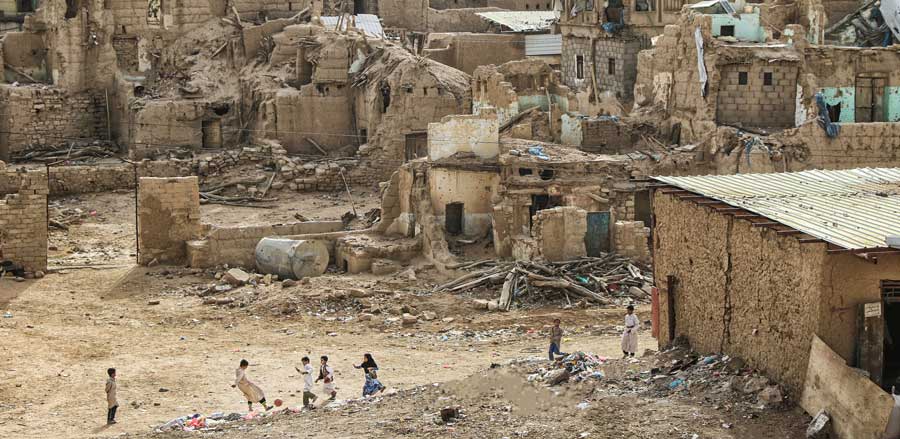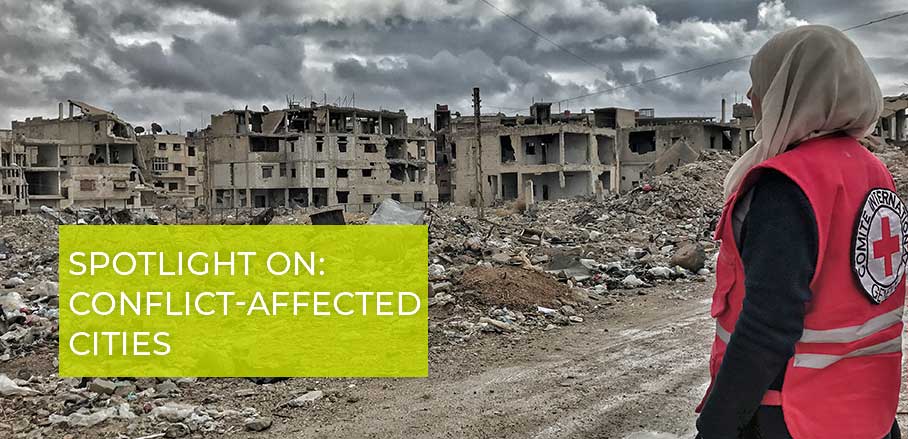Urban Settings Need New Approaches
Traditional relief-rehabilitation-development paradigm does not hold true in urban conflict zones. A combined approach of long-term support for systems reinforcing short-term support for individuals would meet people’s needs, secure development gains, and represent value for money. The cost of failing to adapt is simply too high, argues Peter Maurer, President of the International Committee of the Red Cross (ICRC).
Urbanised Conflicts Reverse Development
“I saw my city die”, is how Sami, a 29-year-old musician, described his flight from Aleppo to Damascus and then on to Beirut. Sadly, such stories of multiple displacement are becoming all too common.
As the world urbanises, armed conflict and violence are urbanising too. The ICRC witnesses first-hand the cumulative humanitarian consequences for city residents caught in the cross-fire. Civilians are killed and injured. Their homes and critical infrastructure on which they depend are damaged or destroyed, such as water, power, sanitation, and health. Previously safe spaces – like schools – become minefields of unexploded ordinances. Displacement and disruption of family life lead to society-wide deficits in jobs and education. And the constant menace of insecurity causes lasting psychological scars. The way wars are fought also impacts sustainable development, creating vast needs.
‘That is why , as we mark the 70th anniversary of the Geneva Conventions this year, I continue to call on all parties to conflict to respect International Humanitarian Law (IHL) during urban warfare and to avoid using explosive weapons with a wide impact area in populated due to the significant likelihood of indiscriminate effects . I also welcome the humanitarian commitments in the New Urban Agenda on International Humanitarian Law, urban services, refugees, IDPs, and migrants.

Saada, Yemen. A group of children play football against a backdrop of destroyed houses. The northern governorate has witnessed several episodes of violence since 2006 that left behind immense destruction © ICRC
Putting Out Fires Is Not Enough
As conflicts urbanise and become longer, humanitarian action has evolved to become much more than emergency response – yet operational planning and funding mechanisms are lagging behind. What is required now is a paradigm shift from ‘putting out fires’ to a combined approach of long-term support for systems which reinforce support for individuals. This may include supporting the physical infrastructure as well as supporting people to gain access to markets and livelihoods, or children to attend schools. Such an approach would meet people’s short and mid-term needs, secure development holds, stem displacement and represent value for money.
I will illustrate this with two examples in the area of essential services, which have been a focus of the ICRC’s urban humanitarian action as a vehicle to reach the most people.
The Case of Gaza
During the 2014 conflict, the ICRC supported a short-term emergency response by acting as a neutral intermediary between conflict parties to coordinate water, wastewater, and power provision, as well as repairs and maintenance of critical infrastructure. Since 2014, the ICRC has moved beyond rehabilitating infrastructure to also trialling a multi-year and multi-sectoral resilient systems approach, in partnership with local authorities. It seeks to understand the interdependencies between services, such as water, sanitation, and power. This in turn allows targeted interventions to extend coverage and build system resilience to future conflict shocks; interventions which ultimately aim to ensure continuity in service delivery during hostilities.
Goma
Here, essential service providers are facing a dilemma: coverage remains low, yet rapid population growth – including from conflict-related displacement – puts increasing pressure on them to expand coverage without the means to do so. In such settings, the ICRC seeks to engage in proactive rather than reactive humanitarian action.This type of support serves a decidedly humanitarian objective: to ensure access to at least a minimum water service with quality levels that promote public health. It provides a foundation for the government, with development actors’ support, to assume full responsibility towards more sustainable targets once , and if, the situation stabilises. Investing in such support represents value for money. For example, a Global Task Force on Cholera Control (GTFCC) case study in the Democratic Republic of the Congo suggests that “by taking proactive action there is up to 50 percent cost savings compared with the ongoing average yearly cost of continuously responding to emerging cholera outbreaks”, which the GTFCC estimates at two billion US dollars per year globally in health care costs and lost productivity.
Towards a New Paradigm
In Goma – as in Gaza – the ICRC’s unique added value lies in its neutrality and acceptance by communities and parties to conflict, its long-term presence in volatile areas, and its ability to operate at individual and systemic levels.
The ICRC will continue to invest in its capabilities to address urban humanitarian needs more holistically: further technical competencies, adapting our internal systems to enable multi-year programming, and reinforcing our logistics capacity, to name a few. But we cannot do it alone.
Deeper engagement between humanitarian and development actors would help translate comparative advantages into more effective and sustainable support to essential service providers operating in the midst or aftermath of conflict. This does not mean sacrificing our neutrality and humanitarian identity; on the contrary, it means meeting basic humanitarian needs on all sides of a conflict in a more sustainable way.
I invite all stakeholders to engage in a reinvigorated dialogue to forge a new paradigm to help people survive and to help cities function in bad times as well as good. The ICRC stands ready to contribute its humanitarian experience and expertise.
Above all, this new paradigm requires three things:
1. Respect for humanitarian law and principles, and the adoption of a policy that avoids the use of heavy explosive weapons with wide area impact in cities, by putting in place sufficient mitigation measures to reduce suffering and facilitate access to populations in need.
2. Multi-year funding that builds resilient urban services and safeguards public health
3. Active partnerships with authorities, communities, and development actors to ensure ownership and sustainability
If we act now, we can meet people’s basic needs in conflict while also helping to build truly resilient cities. If we act now, people like Sami will be able to say, “I saw my city reborn”.
- Urban Settings Need New Approaches - 12. December 2019
